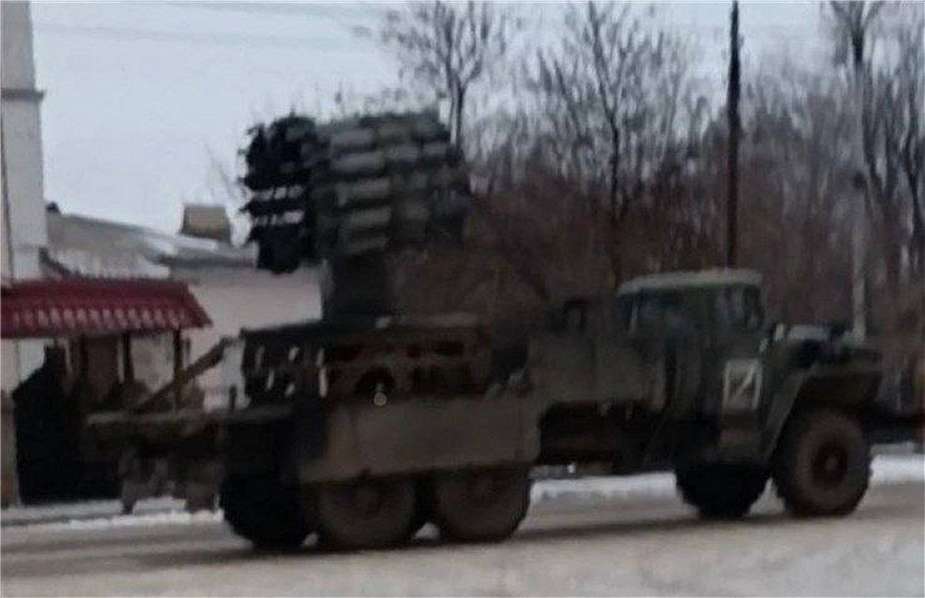- Army
- Conflicts in the world
- Israel - Iran conflict 2025
- Pakistan - India Conflict 2025
- Russia Ukraine War 2022
- Libya conflict day by day
- HAMAS - Israel War 2023
- Operation Serval in Mali French Army
- Sangaris operation Central African Republic
- Sangaris opération militaire République Centreafrique
- Ukraine - Russia conflict
- Syria conflict news
- Defence & Security Industry Technology
- Armies in the world
- Analysis Defense and Security Industry
- Conflicts in the world
- Navy
- Air
Russia Mounts Naval Rockets on Tanks & Trucks to Compensate for Artillery Losses in Ukraine
In the ongoing conflict in Ukraine, Russia has faced significant losses of its rocket launcher systems, prompting the development of new artillery solutions to bolster its military capabilities. The new development includes rocket launchers based on the MTLB tracked chassis and Ural-4320 trucks, which are being armed with RBU-6000 213 mm caliber Soviet anti-submarine rocket launchers, originally designed for naval warfare. Some videos published on social networks also show the RBU-6000 naval rocket launcher system mounted on the chassis of a Russian T-80 tank.
Follow Army Recognition on Google News at this link

RBU-6000 Smerch-2 213 mm caliber Soviet anti-submarine rocket launcher mounted on T-80 tank chassis.(Picture source Video footage Social Network)
These adaptations signify an innovative approach to utilizing existing military hardware for new purposes, especially in the context of land-based operations. The use of anti-submarine rocket launchers in ground warfare is a testament to the changing dynamics of military strategy and the need for versatility in weapon systems.
The conflict in Ukraine has seen intense artillery exchanges, leading to significant losses on both sides. For Russia, the depletion of its rocket launcher inventories has been a critical issue, impacting its operational capabilities and necessitating the development of new artillery systems. The decision to repurpose naval weaponry for ground combat reflects an urgent need to replenish lost equipment and maintain pressure on opposing forces.
The losses have not only been in terms of quantity but also in the sophistication of the weaponry, affecting the strategic balance in the conflict. The adaptation of naval rocket launchers for land use is a creative, yet desperate measure to counteract these losses, highlighting the challenges faced by Russian forces in sustaining their artillery capabilities.
The RBU-6000, known as the Smerch-2 in Russian service, is an anti-submarine rocket launcher system originally designed for naval use. It is capable of launching 213 mm rockets designed to target and destroy submarines at short to medium ranges. The system typically features a salvo of rockets fired in rapid succession, creating a lethal pattern designed to incapacitate or destroy underwater targets.
With a history of service in the Soviet and Russian navies, the RBU-6000 is known for its reliability and effectiveness in anti-submarine warfare. Its adaptation for use in ground combat scenarios against surface targets is an unconventional yet strategic choice, leveraging its high-explosive payload and saturation fire capabilities in terrestrial combat environments.
The RBU-6000, known for its role in anti-submarine warfare, employs a variety of munitions, notably including the 90R rocket and the RGB-60 depth charges. The 90R is an anti-submarine rocket that carries a high-explosive warhead designed to detonate at a specific depth, utilizing hydrostatic pressure fuses. This detonation generates a powerful shockwave aimed at damaging or destroying the hull of a submarine, making it a key asset in naval engagements against underwater threats. Alongside the 90R, the RBU-6000 can also deploy RGB-60 depth charges, which, though not rockets, serve a similar purpose in targeting submarines. These charges are released into the water and sink to predetermined depths where they explode, creating pressure waves to incapacitate or destroy enemy submarines.
The range of fire for the RBU-6000 extends up to 6,000 meters, allowing ships equipped with this system to engage submarines from a safe distance. This capability ensures that surface vessels can maintain a strategic advantage over underwater threats, protecting themselves and their convoys from potential attacks. The versatility and effectiveness of the RBU-6000's munitions make it a valuable component of naval arsenals, especially in environments where the threat of submarine warfare is prevalent.
The repurposing of naval weaponry for land warfare underscores the innovation and adaptability required in prolonged conflicts. Russia's development of new rocket launchers based on the MTLB chassis and Ural-4320 trucks, equipped with RBU-6000 systems, reflects a strategic response to the significant artillery losses experienced in the Ukraine conflict. This adaptation highlights the evolving nature of military tactics and the importance of versatility in weapon systems amidst the challenges of modern warfare.

RBU-6000 Smerch-2 213 mm caliber Soviet anti-submarine rocket launcher mounted on Ural-4320 truck chassis. (Picture source Video footage Social Network)
News Russia Ukraine War


























